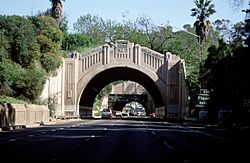Figueroa Street Tunnels facts for kids
 |
|
| Looking northeast through the third and fourth tunnels | |
| Overview | |
|---|---|
| Location | Elysian Park, Los Angeles |
| Coordinates | 34°04′23″N 118°14′02″W / 34.07306°N 118.23389°W |
| Route | Northbound lanes of |
| Start | Northeast of Stadium Way |
| End | Southwest of |
| Operation | |
| Operator | Caltrans |
| Technical | |
| Length | 755, 461, 130, and 405 ft (230, 141, 40, and 123 m, respectively) |
| Tunnel clearance | 28.3 ft (8.6 m) |
| Width | 46.5 feet (14 m) |
The Figueroa Street Tunnels are a group of four tunnels in Los Angeles, California. They carry northbound traffic on State Route 110 through Elysian Park. This road is also known as the Arroyo Seco Parkway. These tunnels are a key part of the city's transportation system. They help thousands of cars move smoothly every day.
The tunnels are different lengths. From south to north, they measure 755, 461, 130, and 405 feet long. Each tunnel is about 46.5 feet wide and 28.3 feet high.
Contents
Exploring the Figueroa Street Tunnels
These four tunnels are designed to make travel easier. They help cars get through the hills of Elysian Park. The tunnels are an important link for drivers heading north in Los Angeles.
What the Tunnels Look Like
The tunnels were designed by engineer Merrill Butler. He also created other famous bridges in Los Angeles. The tunnels feature cool Art Deco patterns. They also have special street lamps and shiny tiles. You can even see eight stylized Seal of Los Angeles designs at the openings.
How Traffic Flows
Many cars use these tunnels every day. Traffic can be heavy at almost any time. At the north end, there's a big interchange with Interstate 5. This is also called the Golden State Freeway. There are also ramps for Solano Avenue after the first tunnel.
A Journey Through Time: How the Tunnels Were Built
The Figueroa Street Tunnels have a long history. They were built to help connect different parts of Los Angeles. Before the tunnels, traffic often got stuck on bridges over the Los Angeles River.
Early Days and Construction
The first three tunnels opened in 1931. They helped cars bypass a busy part of North Broadway. The longest tunnel, the southernmost one, opened a few years later in 1935. It connected directly to Figueroa Street downtown.
In 1937, the Figueroa Street Viaduct was built. This viaduct is a long bridge that crosses the Los Angeles River. It helped separate traffic, with the tunnels carrying eastbound cars and the viaduct carrying westbound cars.
Connecting to Major Roads
Over the years, the tunnels became part of bigger road systems. In 1940, they connected to the Arroyo Seco Parkway. This parkway was one of California's first freeways. It made it much faster to travel between Los Angeles and Pasadena.
Later, in 1953, the tunnels were connected to the famous Four Level Interchange. This is a complex road junction where several major freeways meet. It helped improve traffic flow even more.
Keeping the Tunnels Modern
The tunnels have been updated over time. In April 2008, the lighting system was replaced. New, more efficient lights were installed. This helps keep the tunnels bright and safe for drivers.
Images for kids
See also
- List of tunnels documented by the Historic American Engineering Record in California






